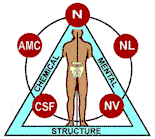|

Applied Kinesiology (AK) is a form of diagnosis using muscle testing as a primary feedback mechanism to examine how a
person's body is functioning. When properly applied, the outcome of an AK diagnosis will determine the best form of therapy
for the patient. Since AK draws together the core elements of many complementary therapies, it provides an interdisciplinary
approach to health care.
In general, the applied kinesiologist finds a muscle that tests weak and then attempts to
determine why that muscle is not functioning properly. The practitioner will then evaluate and apply the therapy that will
best eliminate the muscle weakness and help the patient.
Therapies utilized can include specific joint manipulation
or mobilization, various myofascial therapies, cranial techniques, meridian therapy, clinical nutrition, dietary management
and various reflex procedures.
In some cases, the examiner may test for environmental or food sensitivities by using
a previously strong muscle to find what weakens it.
Applied kinesiology uses the triad of health - chemical, mental
and structural factors - to describe the proper balance of the major health categories.
The triad is represented by
an equilateral triangle with structural health as its base, and the upright sides representing chemical and mental health.
When a person experiences poor health, it is due to an imbalance in one or more of these three factors.
The triad
of health is interactive and all sides must be evaluated for the underlying cause of a problem. A health problem on one side
of the triad can affect the other sides. For example, a chemical imbalance may cause mental symptoms. Applied kinesiology
enables the practitioner to evaluate the triad's balance and direct therapy toward the imbalanced side or sides.
What is the educational background of an applied kinesiologist?
It
takes hundreds of hours of study and years of practice to perfect the multitude of diagnostic techniques that have been developed
in AK. In fact, any AK practitioner will tell you that s/he is constantly refining and developing manual muscle testing skills
and the interpretation of the test results.
At first glance, muscle testing appears easy, fascinating and impressive.
The ability to test muscles, however, requires specific techniques, sensitivity and objectivity. Once the muscle testing skill
has been developed, it becomes necessary to interpret the outcome of the test. Interpreting the results requires the years
of training that qualifies one as a licensed physician. Therefore, applied kinesiology is only taught to persons licensed
to diagnose in the health care field.
To practice AK, one must take a basic course that takes over 100 hours of classroom
study and practice to complete. A basic proficiency exam in AK must be passed at the end of the course. A minimum of 300 hours
of AK instruction, passage of written and oral examinations, and submission of two original research papers are required to
reach the next step; becoming a diplomate of the International Board of Applied Kinesiology (DIBAK). A diplomate represents
the highest level of certification in AK.
Does applied kinesiology replace standard examinations?
Applied kinesiology is
used in addition to standard diagnostics to help determine the cause of a health problem. For example, with certain conditions
like hypoglycemia, there will be muscle patterns of weakness or strength found with AK. However, these same patterns could
be present because of another nervous system problem such as disease or some type of adaptation.
Only an adequate
history of the person, together with standard examination procedures and laboratory findings, will indicate the proper treatment
course. Therefore, people performing a simple muscle test and diagnosing what vitamins are needed or other information about
health without standard examination is inappropriate. This is making health decisions well beyond what a simple muscle test
can determine and actually may be harmful.
The determination of your need for dietary supplements requires knowledge
of your symptoms along with an examination for known physical signs of imbalances and a dietary history. Blood, urine, saliva
or stool analyses may be added to the foregoing. An applied kinesiology examination provides additional information and can
help to determine what is missing and needs supplementation. Using applied kinesiology, a doctor can often determine which
of the many available laboratory tests are the most appropriate to be performed. This can result in a more effective diagnosis
while at the same time reducing health care costs.
Who is eligible to attend a course on applied kinesiology?
The International College
of Applied Kinesiology and the courses offered by the College are only open to those individuals who are health care practitioners,
licensed to diagnose, or students enrolled in an accredited college program who, upon completion, will be granted a license
to diagnose.
|

